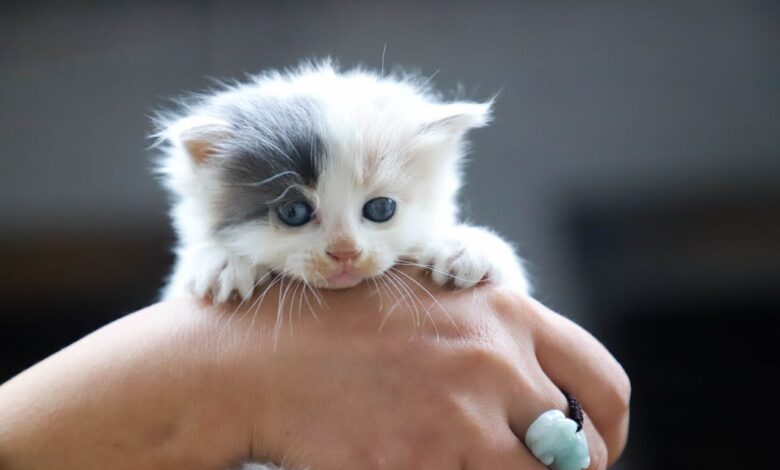Kitten Teething: Comprehensive Guide to Symptoms, and 7 Relief Strategies

Kitten teething is a critical stage in a young cat’s development, often marked by increased chewing, biting, and noticeable changes in behavior. Understanding the teething process, recognizing symptoms, and knowing how to provide relief can help ensure a smooth transition for both the kitten and the owner. This comprehensive guide will explore every aspect of kitten teething, offering practical tips and solutions to manage this essential phase.
Ah, the joys of kittenhood! But amidst all the playful antics and adorable purrs, there’s a phase that can be a bit of a challenge: teething. Those tiny, sharp teeth can cause a lot of discomfort for your little furball, and a bit of frustration for you too. Chewed-up furniture and those sudden, unexpected nips can be a real test of patience. But fear not, help is on the way! Let’s dive into the world of kitten teething and discover effective ways to soothe your furry friend’s discomfort while protecting your home.
What is Kitten Teething?
The Basics of Kitten Teething
Kitten teething, much like in human infants, is the process where a kitten’s deciduous (baby) teeth are replaced by permanent adult teeth. This process typically begins around the age of 3 to 4 months and can continue until the kitten is about 6 months old. During this period, kittens may experience discomfort and exhibit behaviors such as increased chewing and biting.
The process begins when a kitten’s baby teeth, also known as milk teeth, start to emerge at around 2 to 4 weeks old. These teeth are sharp and needle-like, designed to help the kitten transition from mother’s milk to solid food. By the time the kitten is about 8 weeks old, they will have a full set of 26 baby teeth.
At around 3 to 4 months, the teething process begins in earnest. The baby teeth start to fall out as the permanent teeth begin to emerge. This can be a painful and uncomfortable time for the kitten, as the new teeth push through the gums, causing inflammation and soreness. By the time the kitten is 6 to 7 months old, they should have a full set of 30 adult teeth.
Relevant Resource:
Recognizing Kitten Teething Symptoms
Common Signs of Teething in Kittens
Kittens exhibit several signs when they are teething, including:
- Increased Chewing and Biting: Kittens often chew on furniture, cords, and other household items to alleviate discomfort. This behavior helps to massage the gums and facilitate the eruption of new teeth. It’s a natural instinct for kittens to chew on almost anything they can get their little mouths on, from toys to household items, and even your fingers or toes.
- Swollen Gums: Inflamed and red gums are common during teething. You might notice that your kitten’s gums appear more swollen than usual, and they may bleed slightly when touched or during chewing.
- Drooling: Excessive drooling can be a sign of mouth pain. If you notice your kitten drooling more than usual, it could be an indication that their gums are sore and inflamed.
- Behavior Changes: Some kittens become irritable or more vocal during teething. They may also exhibit signs of restlessness or have trouble sleeping due to the discomfort.
- Loss of Appetite: Mouth pain can make eating uncomfortable for kittens. If your kitten seems to be eating less or having difficulty chewing, it could be due to teething pain.
It’s essential to monitor these symptoms and provide appropriate care and relief to help your kitten through this challenging phase.
Relevant Resource:
- PetMD: Kitten Teething Symptoms
The Kitten Teething Timeline
When Do Kitten Teeth Fall Out?
Understanding the timeline of kitten teething can help you anticipate and manage the process more effectively.
Timeline:
- 2-4 Weeks: Deciduous teeth emerge. Kittens start to develop their baby teeth, which consist of 12 incisors, 4 canines, and 10 premolars. These teeth are essential for the initial stages of weaning from mother’s milk to solid food.
- 3-4 Months: Baby teeth start falling out; permanent teeth begin to appear. This is the start of the teething process, where the baby teeth make way for the permanent teeth. The incisors are usually the first to go, followed by the canines and premolars.
- 4-5 Months: Most kittens will start to lose their baby teeth in earnest. The permanent teeth begin to replace the baby teeth, leading to increased chewing and biting as the gums become sore and inflamed.
- 5-6 Months: The majority of permanent teeth will have emerged. During this time, kittens may continue to exhibit teething behaviors as their adult teeth fully erupt.
- 6 Months: Most kittens have all their adult teeth. By this age, a kitten should have a complete set of 30 adult teeth, which include 12 incisors, 4 canines, 10 premolars, and 4 molars.
Understanding this timeline can help you provide the appropriate care and interventions to alleviate your kitten’s discomfort during the teething process.
Relevant Resource:
Managing Kitten Teething Behavior
Why Do Kittens Chew and Bite?
Kittens chew and bite as a way to relieve the discomfort caused by their emerging teeth. It’s a natural behavior but can be problematic if they start chewing on furniture or electrical cords.
Strategies to Manage Behavior:
- Provide Appropriate Chew Toys: Offer safe and suitable teething toys. Chew toys designed for kittens can help satisfy their need to chew and massage their gums, providing relief from teething pain. Look for toys made from durable materials that can withstand the rigors of kitten chewing.
- Kitten-Proof Your Home: Hide cords and protect furniture. Ensure that electrical cords are out of reach or covered with protective casing to prevent your kitten from chewing on them. Use bitter sprays on furniture to deter chewing and provide alternative chewing options.
- Positive Reinforcement: Reward good behavior with treats and affection. Encourage your kitten to chew on appropriate toys by offering treats and praise when they use them. Avoid punishing your kitten for chewing on inappropriate items, as this can create fear and anxiety.
- Regular Playtime: Engage your kitten in regular play sessions to burn off excess energy and reduce boredom, which can lead to destructive chewing behaviors. Interactive toys and games can keep your kitten entertained and less likely to chew on household items.
- Supervision: Keep a close eye on your kitten during the teething period to prevent them from chewing on dangerous items. Redirect their attention to appropriate chew toys when necessary.
Relevant Resource:
- CatHealth: Kitten Teething
Soothing Teething Kittens
Effective Relief Strategies
Relieving teething pain is crucial for the comfort of your kitten. Here are some effective strategies:
- Teething Toys: Provide toys specifically designed for teething kittens. These toys are often made from soft yet durable materials that can help massage the gums and provide relief from pain. Toys with different textures can be particularly effective.
- Frozen Toys: Freeze teething toys to numb the gums and provide relief. The cold temperature can help reduce inflammation and soothe sore gums. You can also freeze a wet washcloth for your kitten to chew on.
- Wet Cloths: Offer a cold, wet cloth for the kitten to chew on. The coolness of the cloth can help alleviate pain and reduce swelling in the gums. Ensure the cloth is clean and free from any harmful substances.
- Massage the Gums: Gently massaging your kitten’s gums can help soothe pain. Use a clean finger or a soft, damp cloth to rub the gums in a circular motion. This can help relieve pressure and reduce discomfort.
- Soft Food: Provide soft food that is easier to chew. Wet food or softened dry food can be gentler on your kitten’s sore gums and reduce the discomfort associated with eating.
- Herbal Remedies: Consider natural remedies such as chamomile tea or aloe vera gel. Chamomile has calming properties that can help soothe inflamed gums, while aloe vera gel can reduce inflammation and promote healing.
- Regular Dental Care: Maintain regular dental care to prevent additional discomfort. Brushing your kitten’s teeth with a kitten-safe toothbrush and toothpaste can help keep their mouth clean and reduce the risk of infections.
Relevant Resource:
- The Spruce Pets: How to Help a Teething Kitten
Best Toys for Teething Kittens
Choosing the Right Toys
Selecting the right toys can make a significant difference in managing a teething kitten’s discomfort. Look for toys that are:
- Durable and Safe: Avoid toys that can break easily or have small parts that could be swallowed. Opt for toys made from high-quality materials that can withstand vigorous chewing.
- Textured: Textured toys can help massage the gums and provide relief from pain. Toys with different surfaces, such as ridges or bumps, can be particularly effective.
- Chilled: Some toys can be frozen to provide additional relief. The cold temperature can help numb the gums and reduce inflammation, making them more comfortable for your kitten to chew on.
Top Toy Recommendations:
- KONG Kitten Toy: Durable and can be stuffed with treats. KONG toys are known for their durability and can provide hours of entertainment for teething kittens. The ability to stuff them with treats adds an extra layer of interest.
- Petstages Dental Health Chews: Designed to improve dental health. These toys are specifically designed to promote dental health by massaging the gums and reducing plaque buildup.
- Nylabone Kitten Chew Toys: Safe and effective for teething kittens. Nylabone toys are made from durable materials that can withstand vigorous chewing and provide relief from teething pain.
- Catit Senses 2.0 Wellness Center: Features a variety of textures and surfaces for kittens to explore and chew on, promoting dental health and providing entertainment.
- SmartyKat Skitter Critters Catnip Toy: Infused with catnip to attract kittens and encourage playful chewing, helping to divert attention from household items.
Relevant Resource:
- Chewy: Best Kitten Teething Toys
Natural Remedies for Kitten Teething
Safe and Effective Home Remedies
Natural remedies can provide relief for teething kittens without the need for medication. Some effective options include:
- Chamomile Tea: Soak a cloth in chilled chamomile tea and let the kitten chew on it. Chamomile has natural anti-inflammatory and calming properties that can help soothe sore gums.
- Aloe Vera Gel: Apply a small amount to the gums to reduce inflammation. Aloe vera is known for its soothing and healing properties and can provide relief from pain and swelling.
- Coconut Oil: Massaging the gums with coconut oil can provide soothing relief. Coconut oil has antibacterial properties and can help reduce inflammation and promote healing.
- Calendula: Calendula is a natural herb that can help reduce inflammation and promote healing. You can make a mild tea from calendula flowers and apply it to the gums with a clean cloth.
- Lavender Oil: Diluted lavender oil can have a calming effect on kittens and help reduce discomfort. Mix a few drops of lavender oil with a carrier oil, such as coconut oil, and gently massage the gums.
- Cold Carrot: Offer a chilled carrot for your kitten to chew on. The coldness can help numb the gums, and the texture provides a satisfying chewing experience.
Relevant Resource:
- Holistic Pet Care: Natural Remedies for Teething Kittens
Diet and Nutrition During Teething
Adjusting Your Kitten’s Diet
Teething can make eating uncomfortable for kittens. Adjusting their diet can help ensure they continue to receive the necessary nutrients for growth and development.
- Soft Food: Offer wet food or soften dry food with water. Wet food is easier for kittens to chew and swallow, reducing the discomfort associated with eating. If you prefer to feed dry food, soak it in water or broth to soften it.
- Frequent Feeding: Smaller, more frequent meals can be easier to manage. Offering smaller portions more frequently can help ensure your kitten gets enough to eat without causing too much strain on their sore gums.
- Nutrient-Rich Diet: Ensure the diet is rich in essential nutrients to support growth and development. Look for high-quality kitten food that provides balanced nutrition, including protein, vitamins, and minerals.
- Supplements: Consider adding supplements to their diet if needed. Omega-3 fatty acids, for example, can help reduce inflammation and promote healthy skin and coat.
- Hydration: Ensure your kitten stays well-hydrated. Wet food can help increase their water intake, but always provide fresh water and encourage your kitten to drink regularly.
- Dental Treats: Offer dental treats designed for kittens. These treats can help clean the teeth and gums while providing a tasty snack.
Relevant Resource:
- Hill’s Pet: Nutrition Tips for Teething Kittens
Kitten Teething and Potty Training
Managing Multiple Developmental Stages
Potty training during the teething phase can be challenging. Here’s how to manage both:
- Consistency: Maintain a consistent potty training routine. Establish a regular schedule for feeding and potty breaks to help your kitten develop good habits.
- Patience: Be patient as your kitten may be distracted by teething pain. Understand that accidents may happen, and avoid punishment. Instead, reinforce positive behavior with praise and rewards.
- Positive Reinforcement: Reward successful potty behavior with treats and affection. Encourage your kitten to use the litter box by offering treats and praise when they do so correctly.
- Comfortable Litter Box: Ensure the litter box is easily accessible and comfortable for your kitten to use. A clean, well-placed litter box can encourage regular use.
- Observe for Signs: Watch for signs that your kitten needs to go, such as sniffing or scratching at the floor. Promptly guide them to the litter box to reinforce the correct behavior.
- Address Distractions: Minimize distractions during potty training sessions. Ensure a calm and quiet environment to help your kitten focus on using the litter box.
Relevant Resource:
- Litter-Robot: Kitten Potty Training Tips
Kitten Teething and Sleeplessness
Helping Your Kitten (and You) Sleep
Teething pain can disrupt your kitten’s sleep patterns. To help:
- Comfortable Sleeping Area: Provide a cozy and quiet sleeping space. A comfortable bed in a quiet, dark area can help your kitten feel secure and promote better sleep.
- Nighttime Routine: Establish a calming nighttime routine. Activities such as gentle play, brushing, or a warm cuddle can help your kitten wind down before bed.
- Teething Toys at Night: Offer a teething toy to alleviate discomfort during the night. Ensure the toy is safe to leave with your kitten overnight.
- Maintain Temperature: Keep the sleeping area at a comfortable temperature. Avoid extremes of heat or cold, as this can disrupt your kitten’s sleep.
- Monitor Noise Levels: Reduce noise levels during the night. Minimize loud noises and disturbances to create a peaceful environment conducive to sleep.
- Provide Comfort: Be available to comfort your kitten if they wake up due to teething pain. Gentle stroking or a soothing voice can help them settle back to sleep.
Relevant Resource:
- PetCoach: Helping Kittens Sleep
Kitten Teething
Teething is a normal part of a kitten’s growth process, but it can be a challenging time for both you and your furry friend. By understanding the signs and implementing some of these soothing strategies, you can help your kitten through this uncomfortable phase. Remember, patience and consistency are key. With a little extra care and attention, you’ll help your kitten navigate this milestone comfortably. Soon enough, those tiny teeth will be replaced by adult pearly whites, and you’ll be left with fond memories of those cute, if sometimes challenging, kitten days.
Relevant Resource:
- American Association of Feline Practitioners: Kitten Care
Frequently Asked Questions: Kitten Teething
1. When do kittens start teething?
Kitten teeth typically start coming in around 3 weeks old, with adult teeth beginning to replace them around 4 months.
2. What are the signs of teething in kittens?
Signs include excessive chewing, drooling, pawing at the mouth, decreased appetite, and irritability.
3. How can I soothe my kitten’s teething pain?
Offer various teething toys, both hard and soft. Consider freezing them for added relief. Gentle massage of the gums can also help.
4. Is it normal for kittens to bite during teething?
Yes, biting is common during teething. Redirect their chewing to appropriate toys and avoid encouraging biting behavior.
5. How long does kitten teething last?
Teething typically lasts for a few months, with most kittens finishing the process around 6 months old.
6. Can I give my kitten human teething products?
No, human teething products are not safe for kittens. Stick to kitten-specific toys and treats.
7. What should I do if my kitten’s gums are bleeding?
If you notice excessive bleeding, consult your veterinarian. Mild bleeding during teething is normal, but excessive bleeding may indicate an issue.
8. How can I protect my furniture from teething kittens?
Use bitter-tasting sprays on furniture and cords. Provide plenty of appropriate chewing alternatives.
9. Will teething affect my kitten’s potty training?
Teething can sometimes cause temporary setbacks in potty training due to increased chewing and exploring. Be patient and consistent.
10. When should I be concerned about my kitten’s teething?
If your kitten shows excessive pain, refuses to eat or drink, or has difficulty breathing, consult your veterinarian immediately.
By following the outlined strategies and using the provided resources, you can ensure a smooth and comfortable teething period for your kitten. Whether it’s through the use of teething toys, adjusting their diet, or employing natural remedies, your efforts will make a significant difference in your kitten’s well-being.







